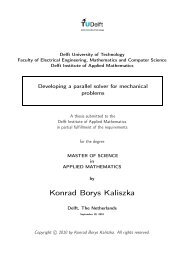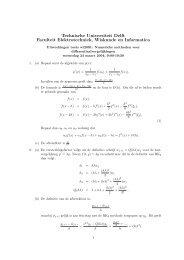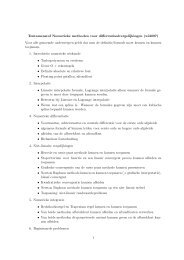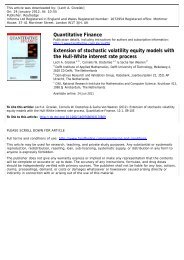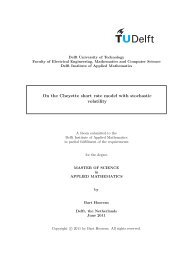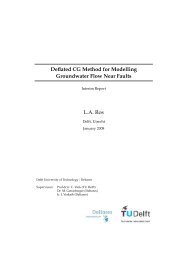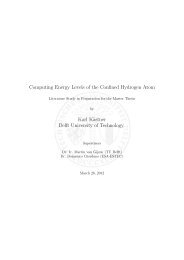AN EVALUATION OF PARALLEL MULTIGRID AS A SOLVER AND A ...
AN EVALUATION OF PARALLEL MULTIGRID AS A SOLVER AND A ...
AN EVALUATION OF PARALLEL MULTIGRID AS A SOLVER AND A ...
Create successful ePaper yourself
Turn your PDF publications into a flip-book with our unique Google optimized e-Paper software.
<strong>MULTIGRID</strong> <strong>AS</strong> A <strong>SOLVER</strong> <strong>AN</strong>D A PRECONDITIONER 107I IIIIV-3 -3I: D 1 = 10, D = 1023 -3II: D = 10, D = 101 2IIIIIII-3 3III: D = 10, D = 101 2IVIV: D = 1, D = 1.1 2IIIIFIG. 9. The domain with the jumping diffusion coefficients.The computational domain with the values of the jumping diffusion coefficients D 1and D 2 is presented in Figure 9. The discretization is vertex centered and all diffusioncoefficients are assumed in the vertices. For the discretized diffusion coefficientbetween two vertices the harmonic average of the neighboring coefficients is thentaken.Clearly our multigrid methods can solve many interface problems, presented, forexample, in [3] or [25]. Here, we constructed a difficult problem, where the robustcomponents of MG1, MG2, and MG3 are not satisfactory. The Krylov acceleration isreally needed for convergence. AMG ([13]), however, solves this problem in approximately15 iterations on different grid sizes.Spectrum analysis. The eigenvalue spectrum obtained with MG2 is presented inFigure 10. Also, for this problem the performance of MG1 and MG2 was almostidentical. In Figure 10 we see two eigenvalues close to one, so multigrid convergenceis already very slow on this coarse grid. With two eigenvalues of the preconditionedmatrix close to zero, this is an example mentioned in Remark 2.1.1. The convergenceof GMRES(20) with MG1, MG2, and MG3 as preconditioners on the 33 2 grid andof GMRES(30) on a 129 2 grid is shown in Figure 11. On the finer grid the restartparameter is raised so that the convergence for this example is not disturbed byrestarts. Multigrid as a preconditioner is converging well. In Figure 11(a) it canbe seen that for the problem on a 33 2 grid the first nine GMRES iterations are notreducing the residual very much, but after iteration nine fast convergence is obtained.This can also be observed after the calculation of the solutions 1 − λ ∗ i related tothe GMRES minimal residual polynomial. These solutions of the eighth and ninthpolynomial are presented in Table 9. Here, it can be seen that the vector belongingto a second eigenvalue of I − AK −1 around one is obtained in the Krylov space in theninth iteration, and then GMRES starts converging very rapidly. In the polynomialfor the interface problem discretized on a 129 2 grid, a second eigenvalue near one wasseen first as solution of polynomial 15, and it was developing even more towards onein polynomial 16. In Figure 11(b) it can be seen that the GMRES convergence forthe 129 2 problem starts after 15 iterations.MG as solver and preconditioner. For this test problem the convergence of thepreconditioned Krylov methods with the MG2 preconditioner on three very fine gridsis presented. The number of BiCGSTAB and GMRES(20) iterations (n) and theelapsed time T elapsed are presented in Table 10. The GMRES convergence is influenced




